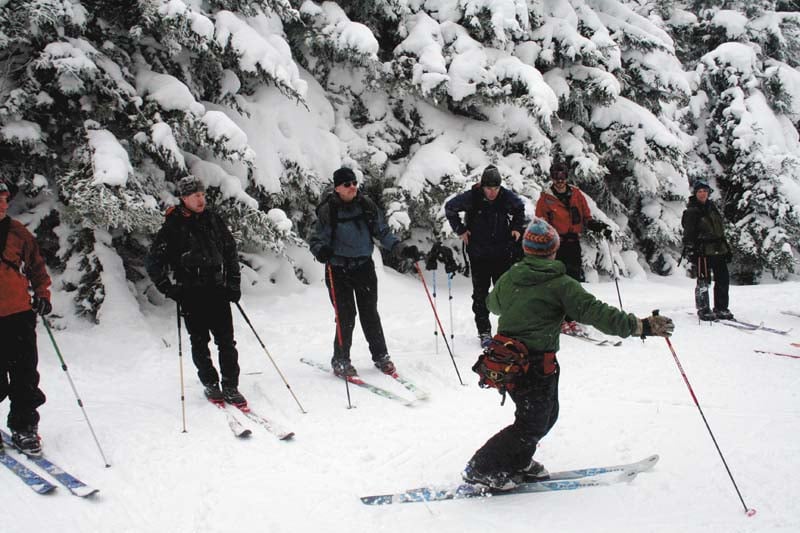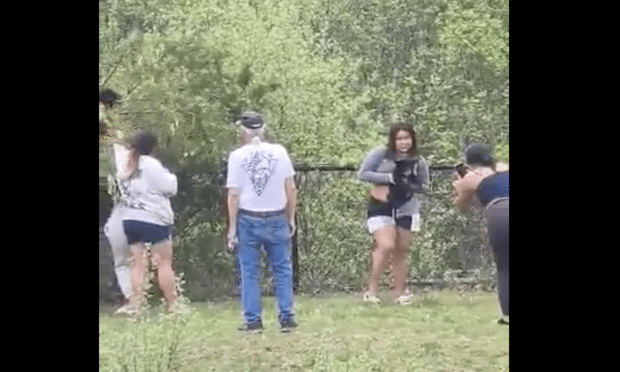Click here for a list of the best telemark skiing destinations in the Southeast.
On a snow-covered hill in West Virginia, there is a large group of men wearing skis and holding hands. I am one of those hand-holding men. We begin skiing together down the hill on telemark skis, and when our instructor yells “turn left,” we all drop our left knee, genuflecting in unison. To spectators, we probably look like a group of first-time skiers on a field trip. In reality, we’re all advanced alpine skiers trying to learn the mystifying art of the telemark turn.
Most skiers in the U.S. grow up using traditional alpine gear—the standard downhill skis, boots, and bindings sold at every ski shop from North Carolina to Oregon. With alpine gear, the skier’s stiff plastic boots are locked into place at the toe and heel. It gives you a secure platform designed to facilitate wedge and parallel turns. Telemark skiing is a different beast altogether. The heels of a telemarker aren’t locked to the ski. They’re loose, allowing for a wide range of movement that is defined by a flamboyant ballet-like turn. Imagine a knight kneeling before his king. That’s what a telemark turn looks like—only the kneeling is done on steep, snow-covered mountains at high speeds.
Telemark is considered the most difficult form of skiing. Its graceful and demanding signature turn separates telemark skiers from the rest of the skiing world. They are a small niche of purists, dedicated to the aesthetics and physicality of the elaborate motion that defines their people. By and large, the alpine skiers and snowboarders who make up the lion’s share of the snowsports demographic look at telemarkers with bewilderment and confusion. Why would anyone choose to do lunges down a mountain?
For me, the telemark turn is like a magic trick, repeated over and over before my eyes. It looks so difficult and painful, and yet so beautiful and fluid. Watching a good telemark turn makes me cringe and smile at the same time.
So here I am, in Canaan Valley, West Virginia, arguably the Mid-Atlantic’s epicenter of all things “freeheel,” trying to make the switch from alpine to telemark. I’m taking a clinic from Dickie Hall, president of the North American Telemark Organization (NATO), that’s booked solid with 30 other advanced downhill skiers trying to break the seal of the telemark turn. Hall teaches several of these clinics each winter across the East, each one packed with skiers just like me wanting to evolve into more graceful skiers and tap into the mystical force that surrounds freeheeling.
According to the Snowsports Industry of America, telemark is the fastest growing snow sport in the country. While snowboard and alpine sales have plateaued, telemark continues to rise. But it’s not likely to become mainstream anytime soon. The learning curve is steep—and so is the cost of gear.
“Skiing telemark forces you to participate with your gear on a physical level unlike any other form of skiing, “ says Dickie. “But there’s a transformation that takes place once you free your heel. Telemark is more difficult, but it changes you.”
* * *
We start on the baby hill displaying our primitive telemark turns for Dickie and his instructing partner, Steve “just call me Stroh” Strothers, so they can get a baseline for our current telemark skills. We ski down the hill one by one, each doing a simulation of what we think the telemark turn looks like. I watch half a dozen of the others ski before me, then dazzle Dickie and Stroh with what I feel could be the world’s greatest first telemark turn. Never mind the fact that I don’t actually turn, my rented telemark skis clanking together, my knees shaking, my entire body off balance.
Sure, there are some kinks I’ll have to work out of my telemark turn, but certainly Dickie will see that I’m a natural, uniquely suited to this difficult art form. I imagine being pulled aside and offered a refund for the clinic. “There’s simply nothing I can teach you, son,” Dickie will say after seeing my virgin telemark turn. “You’ve got it down pat.”
“You’ve got an alpine hangover,” Dickie says to me instead. “You’re trying to apply what you’ve learned through years of alpine skiing to telemark, but it’s a different kind of skiing altogether. You have to forget everything you know about skiing and start over. You have to lose your alpine mentality.”
My “alpine mentality” is affecting everything from where I carry the weight of my body to my relationship with gravity. To help break us from our wicked alpine ways, Dickie drops some key knowledge that unlocks the mystery of the tele turn:
1) When you drop your back knee, balance your weight in the center of your front foot— not on your toes. This provides a stable platform throughout the lunge.
2) Point your front knee in the direction you want to turn, then wait for your skis to follow your knee. Don’t force the turn; let the skis turn you.
Waiting for my skis to turn demands a level of patience and trust that I do not have. The movements in alpine are quick and powerful. Telemark is more languid and controlled. I drop my back knee, keep my weight balanced in the center of my front foot, then point my knee left, but nothing happens. For maybe half a second (which feels like an eternity when you’re skiing toward a tree), I keep going straight. I force myself to stick with it, and the skis do eventually turn, allowing me to complete my first big, swooping telemark turn from one side of the hill to the next.
I spend half the day practicing the mini telemark turn—a half-kneeling sort of movement—on the baby slope with a half dozen other skiers afflicted with “alpine mentality.” Eventually, my “lunges” get deeper and my turns get more precise.
Later, we follow Dickie uphill through the woods, creating big “Z” patterns as we climb up a steep, forested slope. “Your universe changes when you realize this, the act of climbing, is skiing,” he says. “Alpine is all about the downhill, about the fall line. But telemark is about motion. It’s about going up and down. It’s about flow.”
These sort of hippie thoughts pervade the telemark world. Dickie has been trying to convince us all morning that there’s a serious connection between telemark and tai chi. Telemark is, in essence, the counter culture movement of the snowsports world. It is a niche filled with people who are dropping out of the alpine skiing mainstream in order to satisfy a deeper, more personal connection with the mountains they love. Sure, you can ski telemark at any resort—and many people do. But learn to telemark well, and you can move beyond the industrial skiing complex of modern resorts into the backcountry.
Dave Lysey is, hands down, the best telemark skier in our clinic. He’s a nationally ranked biathlete (cross country skiing and target shooting) who’s sleeping in his car in the Whitegrass parking lot this weekend. I asked him what he loves about telemark, and he gives me the standard one word answer: “Freedom.”
Stroh agrees. “Alpine skiing is limited. You can only go in one direction and you can only ski at lift-served resorts. With telemark gear, you can go anywhere, ski anything. Pull your car over on the side of the road, and you can ski any hill you want.”
* * *
On the second day of the clinic, we head up the mountain at Canaan Valley Resort and ski off the backside of the peak, disappearing into a thick canopy of red spruce. There’s some climbing, but it’s easier than you’d think on telemark gear. The key to climbing up a steep slope is to stand up straight and pound your boot into the snow, letting the wax grip the terrain.
In less than an hour, we arrive at the Pipeline, a backcountry run with 2,000 feet of drop that’s cherished by telemark skiers. We move down the Pipeline in small groups, covering a few hundred vertical feet, then resting for a few minutes before moving on to the next section of the run. The pitch is steeper than what we skied the day before, and most of my newfound telemark skills are falling apart. Instead of turning, I glide into the thick, forested edges of the trail and fall over.
“You’re posing!” Dickie yells to me from the bottom of a pitch. “You’re trying to be a picture of the telemark skier.” He goes on to explain to all of us the core difference between telemark and alpine. “Forget the static jerking of alpine. Telemark is about fluid movement. As soon as you sink to the bottom of your turn, you should be rising back up again. Rise and fall softly.”
Slowly, I get a little better—by ‘better,’ I mean fewer face plants and tree collisions.
Soon we find ourselves at the beginning of an intimidating tree run, where each tree looks like a concussion or broken collar bone.
“Eventually, you stop seeing the trees and you only see the spaces between the trees,” Dickie says, in true Zen Master form.
Better skiers head straight down the line, rising and falling perfectly with their advanced telemark skills. I make my way down slowly and carefully, cutting big “S’s” into the hill by skiing against the fall line. It’s a slow process, but it feels good. I’m in the woods of Canaan Valley skiing tree runs with a foot of fresh powder. This is why I wanted to free my heel in the first place: I can ski up and down and sideways, with the entire, snowy world at my freeheelin’ feet.
Click here for a list of the best telemark skiing destinations in the Southeast.







